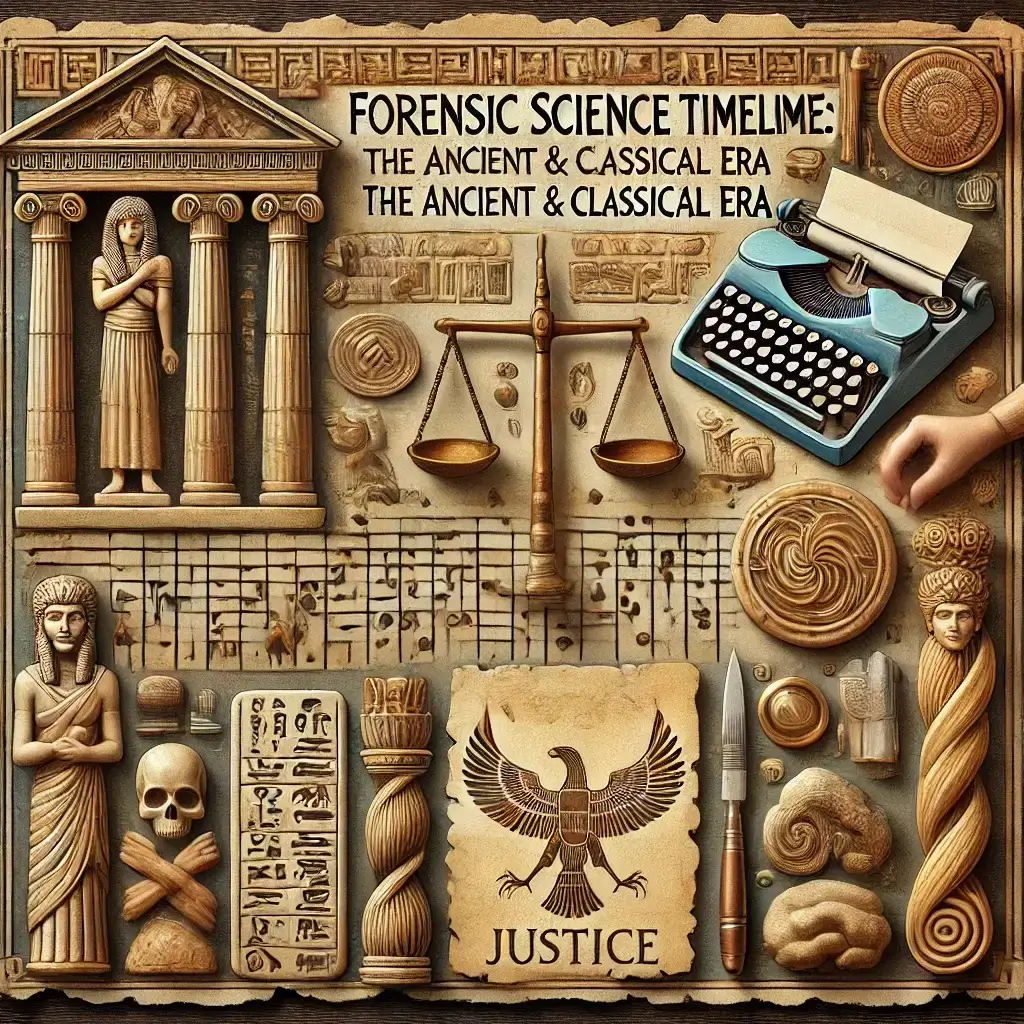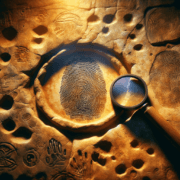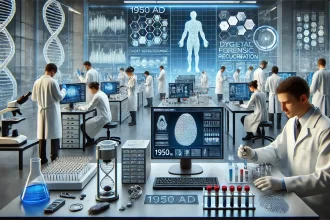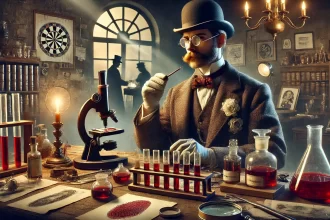Discover how the Ancient & Classical Era of Forensic Science
- Key Milestones in the Ancient & Classical Era (Prehistory to 500 AD):
- Prehistoric Fingerprints: Early Evidence of Unique Identity in Rock Art
- 2200 BC: Hammurabi’s Code: The First Laws Governing Medical Practice and Ethics (2200 BC)
- 460-355 BC: Hippocrates: The Father of Medicine and Early Forensic Thought
- 384-327 BC: Aristotle’s Contributions to Science: Paving the Way for Forensic Investigation
- 339 BC: Socrates’ Execution: Poisoning and Early Knowledge of Toxicology
- 300 BC: Herophilus’ Groundbreaking Human Dissections in Ancient Alexandria
- 287-212 BC: Archimedes’ Eureka Moment: The Birth of Forensic Engineering
- 230 BC: The First Lie Detection Test: Erasistratus and the Science of Lies
- 44 BC: Julius Caesar’s Assassination: How Ancient Rome’s First Autopsy Changed History
- 49 AD: Forensic Dentistry in Ancient Rome: Agrippina’s Identification of Lollia Paulina
- 50-70 AD: Dioscorides and De Materia Medica: The Foundation of Forensic Toxicology
- 53-96 AD: Quintilian and Bloody Handprints: The First Use of Forensic Evidence in Court
- 400s: Forensic Medicine in Early Germanic and Slavic Societies: The Role of Medical Experts
- Conclusion
Forensic science has deep roots in ancient civilizations. The earliest applications of forensic methods were found in prehistoric times in societies like Babylon, Greece, and Rome. This era marks the first recorded use of fingerprintsFingerprint, impression made by the papillary ridges on the ends of the fingers and thumbs. Fingerprints afford an infallible means of personal identification, because the ridge arrangement on every finger of every human being is Read Full Definition for identification, the examination of wounds in legal cases, and the development of early poison detection methods. The foundations of forensic medicine were laid during this time, influencing later innovations in the field.
Discover how the Ancient & Classical Era contributed to the development of forensic science, and follow the journey into the Medieval Era and beyond to see how these early methods evolved.
Key Milestones in the Ancient & Classical Era (Prehistory to 500 AD):
Prehistoric Fingerprints: Early Evidence of Unique Identity in Rock Art
Prehistoric humans recognized the uniqueness of fingerprints long before modern forensic science. Evidence
Read more about The Utilization of Fingerprints by Prehistoric Humans: A Glimpse into Early Identity and Expression.
2200 BC: Hammurabi’s Code: The First Laws Governing Medical Practice and Ethics (2200 BC)
Around 2200 BC, the Babylonian King Hammurabi introduced one of the earliest known sets of laws, the Code of Hammurabi, which included regulations on medical practices. The code contained detailed provisions for the responsibilities of physicians, including the treatment of patients and the payment for services rendered. It also outlined the consequences of medical malpractice, establishing one of the first frameworks for medical ethics and practices. This significant historical development laid the groundwork for the intersection of law and medicine.
Read more about Hammurabi’s Code and Medical Practices.
460-355 BC: Hippocrates: The Father of Medicine and Early Forensic Thought
Hippocrates, the father of medicine, was among the first to explore the intersection of medical knowledge and legal matters. In ancient Greece, his study of the lethality of wounds laid the foundation for forensic medicine. His work in understanding how injuries affect the body provided critical insights that later influenced the investigation of the cause of deathThe cause of death refers to the specific injury, disease, or underlying condition that directly leads to an individual's demise. It is a critical determination made by medical professionals, such as Medical Examiners or Coroners, Read Full Definition in criminal cases. Hippocrates’ contributions to medicine were not just confined to healing but extended to forensic practices that would later become essential in legal contexts.
Read more about Hippocrates and Forensic Medicine.
384-327 BC: Aristotle’s Contributions to Science: Paving the Way for Forensic Investigation
Aristotle, one of the most influential figures in Western philosophy, contributed greatly to developing scientific thought that would later play a crucial role in forensic science. A student of Plato and tutor to Alexander the Great, Aristotle’s methods of systematic observation and categorization laid the groundwork for logical reasoning and evidence-based analysis, principles that are essential in modern forensic investigations. His observations on the natural world, including autopsies and dissections, provided early insights into biology and anatomy, which would later be applied in criminal investigations to determine causes of death and study human behavior.
Learn more about Aristotle’s Influence on Forensic Science.
339 BC: Socrates’ Execution: Poisoning and Early Knowledge of Toxicology
In 339 BC, the philosopher Socrates was executed by ingesting a cup of hemlock, marking one of the earliest recorded uses of poison in a legal execution. This event is significant in the history of forensic toxicology, as it demonstrates the Greeks’ understanding of toxic substances and their effects on the human body. Greek literature, including stories of Ulysses and Hercules, references poisons, such as serpent venom, further reflecting the ancient world’s awareness of toxic agents. Socrates’ execution by poison contributed to the study of lethal substances and their detection, which would later become central to forensic toxicology.
Read more about Socrates and Early Toxicology.
300 BC: Herophilus’ Groundbreaking Human Dissections in Ancient Alexandria
In 300 BC, Herophilus, a pioneering Greek physician and anatomist, became one of Alexandria’s first known scientists to perform human dissections. His groundbreaking work in anatomy involved detailed studies of the human body, including the brain, nerves, and cardiovascular system, significantly advancing medical and forensic knowledge. Herophilus’ dissections were critical in laying the foundations for understanding postmortem changes and the human body’s inner workings, which would later influence forensic pathology and autopsyAn autopsy, also known as a post-mortem examination or necropsy (when performed on animals), is a thorough and systematic medical procedure that involves the examination of a deceased person's body, typically to determine or confirm Read Full Definition techniques. His work also set the stage for the future development of forensic medicine by contributing to a better understanding of how the body reacts to trauma and disease.
Read more about Herophilus’ Contributions to Anatomy.
287-212 BC: Archimedes’ Eureka Moment: The Birth of Forensic Engineering
In 287-212 BC, Archimedes, the brilliant Greek mathematician and inventor, made his famous “Eureka!” discovery while attempting to determine whether a gold crown was pure or adulterated with silver. Using the principle of water displacement, Archimedes demonstrated that the volume of an object could be measured by the amount of water it displaced, establishing the foundational concept of density. This moment not only influenced physics but also laid the groundwork for forensic engineering, introducing methods of analysis that would later be crucial in crime investigations. Archimedes’ application of scientific principles to solve real-world problems marked a significant step toward using quantitative, empirical techniques in forensic sciences, such as determining the authenticity of materials or the forces at play in various criminal cases.
Read more about Archimedes and Early Forensic Engineering.
230 BC: The First Lie Detection Test: Erasistratus and the Science of Lies
In 230 BC, Erasistratus, an ancient Greek physician, made a groundbreaking observation in his study of the human body: he noticed that his patients’ pulse rates would increase when they were lying. This early recognition of physiological changes during deception marked the first documented use of physiological cues for lie detection, laying the foundation for what would later evolve into modern polygraph techniques. Erasistratus’ work showed that emotions, particularly stress and anxiety, could manifest physically, a concept that would become central to the science of detecting lies in forensic psychology.
Learn more about Erasistratus and Early Lie Detection.
44 BC: Julius Caesar’s Assassination: How Ancient Rome’s First Autopsy Changed History
After the assassination of Julius Caesar in 44 BC, a physician conducted an early forensic autopsy on his body, determining that only one of the 23 stab wounds was fatal. This examination not only provided key insights into Caesar’s cause of death but also marked a significant moment in the history of forensic medicine. The autopsy was one of the earliest documented cases of using medical knowledge to investigate a suspicious death, setting a precedent for the use of postmortem examinations in criminal investigations in later centuries.
Read more about Caesar’s Assassination and Forensic Autopsy.
49 AD: Forensic Dentistry in Ancient Rome: Agrippina’s Identification of Lollia Paulina
In 49 AD, Agrippina, the mother of Emperor Nero, identified the head of her enemy, Lollia Paulina, through a distinctively colored tooth. This early use of forensic dentistry represents one of the first documented instances of using dental characteristics for identification purposes in forensic investigations.
Learn more about Forensic Dentistry in Ancient Rome.
50-70 AD: Dioscorides and De Materia Medica: The Foundation of Forensic Toxicology
Pedanius Dioscorides, a Greek physician residing in Rome, made significant contributions to the field of forensic toxicology through his work De Materia Medica. In this text, he systematically categorized medicinal plants, their therapeutic properties, and the toxic effects they could have when misused. His detailed observations laid the groundwork for forensic toxicology by providing an understanding of poisons and their symptoms, which later became invaluable in criminal investigations involving toxic substances.
Read more about Dioscorides and Forensic Toxicology.
53-96 AD: Quintilian and Bloody Handprints: The First Use of Forensic Evidence in Court
Quintilian, a prominent Roman orator and attorney, made a groundbreaking contribution to forensic evidence in the courtroom. Using scientific reasoning, he disproved the authenticity of bloody handprints presented as key evidence in a murder trial. Quintilian demonstrated that the bloody palm prints did not belong to the accused murderer, revealing that they were planted to frame a blind man for the murder of his mother.
Read more about Quintilian and Early Forensic Evidence.
400s: Forensic Medicine in Early Germanic and Slavic Societies: The Role of Medical Experts
In the 400s, Germanic and Slavic societies established laws that formalized the role of medical experts in determining causes of death in criminal cases. These early legal frameworks mandated that physicians or medical practitioners be consulted to examine bodies and provide expert testimony regarding the circumstances of death. This laid the foundation for forensic medicine as a distinct field, marking the beginning of integrating medical expertise into legal proceedings. It also set a precedent for future systems where medical professionals would play critical roles in criminal investigations, especially in cases of suspected foul play.
Learn more about Forensic Medicine in Early Societies.
Conclusion
The Ancient & Classical Era laid the foundation for many forensic techniques, from the early use of fingerprints in Babylon to the scientific observations of Aristotle. These early innovations in medicine, legal systems, and criminal investigations have continued to influence the development of forensic science. As we move forward through history, you’ll see how these primitive practices evolved into more sophisticated methods, laying the groundwork for the advancements to come.











